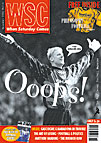 West Brom fan Jaz Baines puts the case for his club making more of an effort to recruit players from ethnic minority backgrounds
West Brom fan Jaz Baines puts the case for his club making more of an effort to recruit players from ethnic minority backgrounds
According to the PFA about one in five professional footballers in the Premiership and Nationwide League are black. To judge by the latest Rothmans, fifteen clubs had no black players on their books last season. Black players will always come and go, of course, and there may be other mitigating circumstances, not least the fact that clubs situated in areas like Yorkshire & Humberside and Tyne & Wear, where the black population is 0.7 per cent and 0.2 per cent respectively, are less likely to recruit black players than clubs in London or the Midlands. However, while the presence of the likes of Tranmere, York, Grimsby and Hartlepool on this list is no surprise, the inclusion of West Bromwich Albion ought to raise a few eyebrows.
In the late 1970s West Bromwich Albion had both an exciting First Division team and a groundbreaking one, with three black players, Brendan Batson, Cyrille Regis and the late Laurie Cunningham, in my opinion the best black player ever seen in British football, featured in key roles. A group of local black academics at Birmingham University started to watch Albion because of these players’ presence. So, too, did members of the black community around Handsworth.
Ray Spence was one such local black fan. He recalls the almost overnight interest in the Albion which took place among local black youngsters: “Before the likes of Batson, Regis and Cunningham most of us black kids were only interested in playing football. Suddenly every black kid was imitating Regis or Cunningham. It was at that time I started going down the Hawthorns. I know this may sound odd but being black put you on a bit of a pedestal. White Baggies fans – complete strangers – used to go almost out of their way to say, ‘Alright mate.’ I don’t think they would have made the effort if the team didn’t have black players.”
Their impact at the club and within the wider community was such that it moved the then chair of the Community Relations Council to remark in 1978 that: “These footballers have done as much for community relations here as we could have hoped to have done in five or ten years. The National Front and other racialist organisations say here is no real multi-racialism, that it is something forced upon the British people against their will. The West Bromwich experience proves that this is not so.”
So what happened to the ‘model’ club for the integration of black football talent? (The Albion fanzine Grorty Dick is troubled by the situation to the extent that a recent front cover was given over to a picture of Nelson Mandela and a caption which read “I am here to help you recruit”). What particularly rankles with Baggies fans now is the significant presence of black footballers at other West Midlands clubs: Aston Villa, Birmingham City, Wolverhampton Wanderers, Coventry City and Walsall are all situated within the 25 mile radius of the West Midlands Metropolitan County, which contains, at 14.5 per cent, the highest ethnic minority population outside Greater London. So why is it that Albion appear to have such a problem recruiting black players? This, of course, assumes that the club perceives there is a problem.
In response to supporters’ questions relating to this issue, manager Alan Buckley has stated at public forums that he does not consider himself to be a racist. And youth team coach Richard O’Kelly has made known his intentions to scout Asian players, having attended the summer Asian football tournament and a local Asian clubs presentation evening.
Supporters like Sukdhev Singh, a Hawthorns regular for 15 years, however, remain unconvinced about the club’s commitment against racism. “Buckley falls into the traditional stereotyping mould when it comes to foreign players. Apparently the Albion had an African on trial. According to Buckley his apparent lack of enthusiasm for training, and cold English conditions was typical of ‘black African footballers’.” But locally, Dwight Yorke, Peter Ndlovu and Walsall’s trio of John Keister, Charlie Ntamark and Kyle Lightbourne have all made their mark. So why couldn’t the Albion follow suit and revive their proud traditions? Two largely ethnic minority-populated districts, Handsworth and Smethwick, lie directly to the north and south of the Hawthorns. Surely it is not beyond Albion to establish stronger links with these local communities with a view to unearthing another Laurie, Cyrille or Brendan? Or even the first British Asian superstar? That’s the challenge to this once pioneering club that has, since the early 1980s, simply buried its head in the sand.
From WSC 118 December 1996. What was happening this month